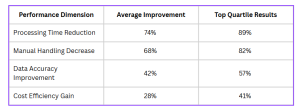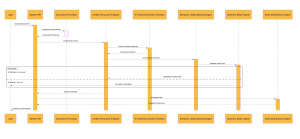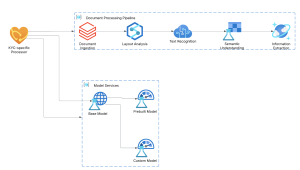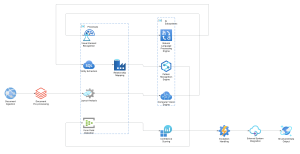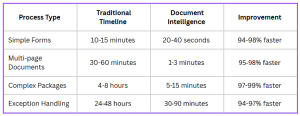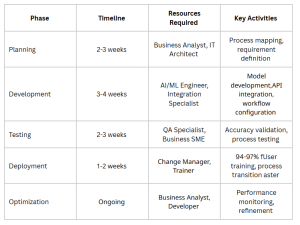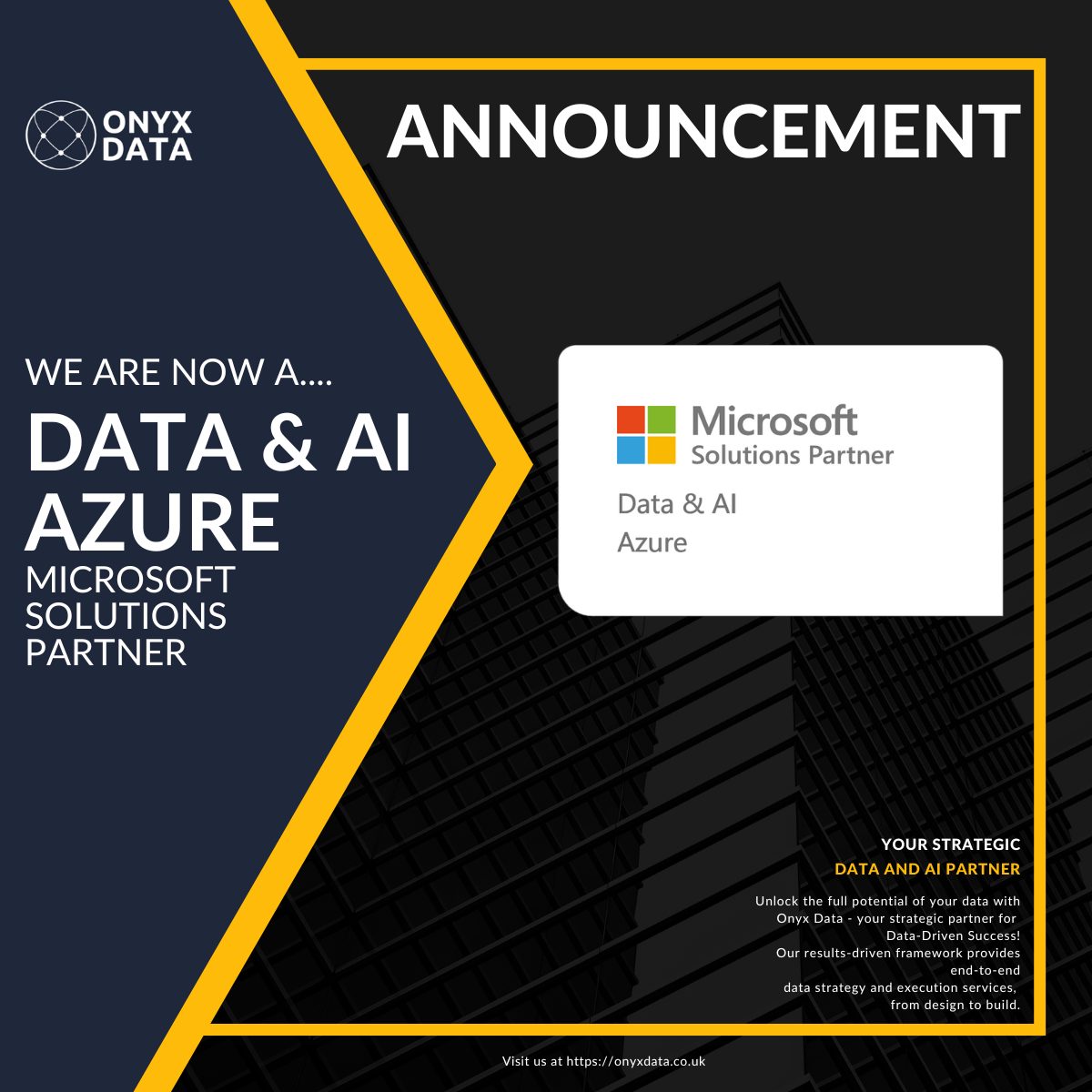Azure Document Intelligence: Breaking the Document Processing Barrier
Document Intelligence Revolution
Document processing—the unglamorous, often-overlooked function consuming enterprise resources—represents the final frontier of digital transformation. While organizations have revolutionized virtually every aspect of operations, document handling remains stubbornly analog in its resource requirements.
Azure Document Intelligence shatters this paradox by embedding sophisticated AI capabilities into document workflows. This isn’t incremental improvement; it’s a fundamental reinvention of how organizations extract, process, and leverage document-based information.
The transformational impact emerges across three critical dimensions:
- Cycle Time Reduction: Processing times shrink from days to minutes, accelerating key business functions like customer onboarding, invoice approvals, and loan applications.
- Scalable Processing: Document throughput multiplies without the need for proportional increases in staffing, empowering organizations to handle growth without operational bottlenecks.
- Enhanced Compliance & Accuracy: AI-driven, rules-based processing minimizes human error and ensures adherence to regulatory standards, reducing the risk of costly compliance breaches.
Key Areas of Application:
- Financial Services: Automate loan processing, extract data from tax forms, and streamline KYC (Know Your Customer) checks.
- Healthcare: Digitize patient records, speed up claims processing, and simplify prior authorization workflows.
- Legal & Contracts: Rapidly review and classify contracts, identify key clauses, and manage legal documentation with precision.
- Supply Chain & Logistics: Process invoices, shipping manifests, and purchase orders with minimal human intervention.
- Government & Public Sector: Accelerate citizen service delivery by digitizing and processing applications, permits, and case files.
Organizations implementing Document Intelligence achieve extraordinary performance improvements:
Let’s explore the technological foundation enabling these transformational outcomes and the strategic implementation approach that maximizes business value.
Breaking Free from Manual Processing Constraints
Document processing challenges manifest in four specific operational constraints that undermine business performance:
Speed Limitations Manual document processing creates fundamental throughput constraints. Even the most skilled processor can only handle a finite document volume, creating inevitable backlogs during peak periods and establishing a direct correlation between volume and headcount.
Accuracy Vulnerabilities Human processing introduces unavoidable error potential. Studies indicate data entry error rates between 1-4% even among skilled operators, with higher rates during periods of fatigue or high volume. Each error initiates costly exception handling processes.
Compliance Inconsistency Manual processing creates inherent compliance variability. Individual processors interpret guidelines differently, apply inconsistent scrutiny, and inevitably miss critical details. This variability represents significant regulatory exposure.
Scalability Constraints Traditional processing cannot scale efficiently with business growth. The linear relationship between document volume and processing resources creates hiring, training, and management challenges that constrain organizational agility.
Document Intelligence directly addresses these constraints through revolutionary technology that fundamentally transforms the economics and performance characteristics of document processing.
The Technology Powering Document Transformation
3.1 Five-Stage Intelligence Pipeline
Azure Document Intelligence employs a sophisticated five-stage processing pipeline that transforms unstructured documents into structured business data:
- Document Acquisition Framework
- Processes multiple formats (PDF, JPEG, PNG, TIFF, BMP)
- Handles documents up to 500 pages or 50MB
- Supports both batch and real-time processing modes
- Provides flexible ingestion APIs for system integration
- Content Structure Analysis
- Applies computer vision to identify document elements
- Maps spatial relationships between components
- Identifies tables, forms, sections, and headings
- Determines reading order and logical flow
- AI-Powered Content Extraction
- Converts visual elements to machine-readable text
- Supports 164 languages across multiple character sets
- Processes handwritten, typed, and printed content
- Maintains formatting integrity during conversion
- Semantic Understanding Engine
- Recognizes document types through content patterns
- Identifies key-value relationships without explicit templates
- Extracts tabular data with structure preservation
- Understands context across document sections
- Business Rule Application
- Validates extracted data against expected formats
- Applies confidence scoring to extraction results
- Routes exceptions based on confidence thresholds
- Integrates with downstream business systems
This comprehensive pipeline enables extraction of business-critical information from virtually any document type with minimal configuration while maintaining high accuracy levels.
3.2 Model Ecosystem Architecture
Azure Document Intelligence technology stack UML diagram showing processing pipeline components and their relationships
Document Intelligence leverages a sophisticated model ecosystem balancing immediate value with specialized capabilities:
Prebuilt Model Portfolio The platform includes specialized models for common document types:
- General Document Model for universal extraction
- ID Document Model for identity verification
- Invoice Model for accounts payable automation
- Receipt Model for expense processing
- W-2 Model for tax documentation
- Business Card Model for contact management
Custom Model Framework Organizations can extend capabilities through tailored models:
- Custom Extraction Models for specialized documents
- Classification Models for document routing
- Composed Models for multi-stage processing
Continuous Learning System The platform incorporates operational feedback:
- Performance monitoring across extraction tasks
- Exception pattern identification
- Model refinement based on verified results
- Confidence threshold optimization
This model architecture enables organizations to address immediate document challenges while building specialized capabilities aligned with unique business requirements.
3.3 AI-Powered Extraction Framework
At its core, Document Intelligence employs advanced AI techniques that fundamentally transform extraction capabilities:
Computer Vision Systems
- Layout analysis algorithms identify document structure
- Visual element recognition identifies tables, images, and sections
- Spatial relationship mapping preserves content context
- Format variation handling adapts to document differences
Natural Language Processing
- Contextual understanding improves extraction accuracy
- Entity recognition identifies names, dates, and key information
- Relationship mapping connects related information
- Language adaptation handles multilingual content
Pattern Recognition Engines
- Document classification through content patterns
- Key-value pair identification without templates
- Table structure recognition across formats
- Form field detection and extraction
This AI foundation enables Document Intelligence to handle complex, variable document types with minimal configuration while maintaining high accuracy levels—a fundamental advantage over traditional template-based approaches.
Hard Numbers: The Business Case for Document Intelligence
The business case for Document Intelligence emerges through quantifiable impact across four performance dimensions:
Processing Velocity Document Intelligence transforms processing timeframes:
Resource Optimization The technology fundamentally transforms resource requirements:
- 68-82% reduction in manual processing headcount
- 300-500% increase in documents processed per FTE
- 70-85% decrease in processing backlogs
- 40-60% reduction in overtime costs during peak periods
Error Reduction Document Intelligence dramatically improves accuracy:
- 35-50% reduction in data entry errors
- 60-75% decrease in exception processing volume
- 40-55% improvement in straight-through processing rates
- 70-85% reduction in customer remediation requirements
Cost Transformation The economic impact manifests across multiple dimensions:
- 20-35% reduction in cost per document processed
- $15-25 million annual savings for large enterprises
- 40-60% reduction in compliance-related penalties
- 6-9 month payback period on implementation investment
This compelling business case demonstrates why Document Intelligence represents a strategic investment with immediate and sustainable ROI.
Strategic Implementation Roadmap
Organizations maximize Document Intelligence value through structured implementation:
5.1 Assessment and Planning
The foundation phase establishes implementation priorities:
Document Process Audit
- Inventory document types across business functions
- Map current processing workflows and timelines
- Identify high-volume and high-complexity processes
- Quantify current costs and performance metrics
Value Prioritization Framework
- Assess document types by volume, complexity, and business impact
- Calculate potential ROI for each document category
- Develop phased implementation roadmap
- Secure executive sponsorship and funding
Technical Readiness Assessment
- Evaluate integration requirements with existing systems
- Assess document acquisition mechanisms
- Identify compliance and security requirements
- Determine change management approach
This structured assessment ensures implementation efforts focus on highest-value opportunities.
5.2 Proof of Concept Deployment
Initial implementation validates the approach through controlled deployment:
Implementation Timeline and Requirements
Success Criteria Framework
- Establish accuracy benchmarks (95%+ for critical fields)
- Define processing time improvement targets
- Set exception rate thresholds
- Determine user acceptance metrics
Expansion Planning
- Document lessons learned from initial implementation
- Refine integration approach based on results
- Develop training materials for broader deployment
- Establish governance mechanisms
This controlled initial implementation validates the approach while building organizational expertise.
5.3 Enterprise Scaling Strategy
Full-scale deployment extends Document Intelligence across the organization:
Deployment Acceleration Framework
- Establish Center of Excellence for implementation support
- Develop reusable integration components
- Create standardized training materials
- Implement performance monitoring dashboard
Process Integration Strategy
- Map document flows across business processes
- Identify integration points with existing systems
- Develop end-to-end workflow orchestration
- Implement exception handling procedures
Governance Structure
- Establish performance metrics and reporting
- Create model management procedures
- Develop compliance documentation
- Implement continuous improvement mechanisms
This structured scaling approach ensures consistent implementation quality while accelerating adoption across the enterprise.
KYC Transformation Case Study
Know Your Customer (KYC) processes exemplify the transformational impact of Document Intelligence:
6.1 Identity Verification System
Document Intelligence transforms identity verification through comprehensive document analysis:
Implementation Architecture
- Multi-channel document capture (web, mobile, branch)
- ID document classification and routing
- Machine Readable Zone (MRZ) extraction and validation
- Security feature verification
- Biometric data isolation for comparison
Performance Improvements
- 75-85% reduction in processing time
- 40-55% decrease in manual verification requirements
- 30-45% improvement in first-pass success rates
- 65-80% reduction in customer remediation needs
Business Impact
- 1-3 day reduction in account opening timelines
- 25-40% improvement in conversion rates
- 15-30% decrease in abandonment rates
- 40-60% reduction in onboarding costs
This transformation converts identity verification from a business bottleneck to a competitive advantage.
6.2 Financial Document Analysis
Document Intelligence revolutionizes financial document processing:
Capability Framework
- Income verification through document analysis
- Employment validation through document extraction
- Asset documentation through statement analysis
- Liability identification through obligation extraction
Performance Metrics
- 70-80% reduction in financial analysis time
- 35-50% improvement in data accuracy
- 60-75% decrease in manual review requirements
- 40-55% faster decisioning timelines
Business Outcomes
- More consistent risk assessment
- Reduced exception processing
- Improved customer experience
- Enhanced regulatory compliance
This transformation enables faster, more accurate financial assessments while improving risk management.
6.3 Compliance Acceleration Framework
Document Intelligence enhances regulatory compliance through systematic processing:
Implementation Components
- Rule-based verification engine
- Regulatory requirement mapping
- Documentation generation system
- Audit trail creation
Performance Improvement
- 60-75% faster compliance verification
- 40-55% reduction in compliance exceptions
- 70-85% decrease in regulatory findings
- 30-45% improvement in audit readiness
Business Impact
- Reduced regulatory risk exposure
- Decreased compliance staffing requirements
- More consistent regulatory adherence
- Enhanced audit preparation capabilities
This compliance transformation converts regulatory requirements from business constraints to systematic processes.
Industry Transformation Examples
Document Intelligence delivers specialized value across different industries:
7.1 Financial Services
Banking and financial institutions achieve significant operational improvements:
Lending Operations
- 70-85% faster loan document processing
- 40-55% reduction in underwriting timelines
- 30-45% improvement in data accuracy
- 25-40% increased capacity with existing staff
Account Services
- 60-75% faster account maintenance processing
- 35-50% reduction in exception handling
- 40-60% improvement in customer service times
- 20-35% decreased operational costs
Treasury Management
- 65-80% faster transaction documentation processing
- 40-55% improved straight-through processing
- 30-45% reduction in payment delays
- 25-40% enhanced operational efficiency
7.2 Healthcare
Healthcare organizations transform document-intensive workflows:
Patient Administration
- 60-75% faster intake form processing
- 40-55% reduction in demographic errors
- 35-50% improved insurance verification
- 25-40% reduced administrative costs
Clinical Documentation
- 55-70% faster medical record processing
- 35-50% improved information accessibility
- 40-55% enhanced documentation compliance
- 30-45% reduced provider documentation time
Revenue Cycle Management
- 65-80% faster claims documentation processing
- 40-55% reduction in claim rejections
- 30-45% improved reimbursement timelines
- 25-40% enhanced revenue capture
7.3 Legal Operations
Legal departments and law firms achieve substantial efficiency gains:
Contract Management
- 70-85% faster contract analysis
- 35-50% improved clause identification
- 40-55% reduced contract review time
- 25-40% enhanced compliance verification
Litigation Support
- 65-80% faster document discovery
- 40-55% improved relevant document identification
- 35-50% reduced review costs
- 30-45% enhanced case preparation speed
Corporate Governance
- 60-75% faster regulatory document processing
- 35-50% improved compliance documentation
- 40-55% reduced governance administration costs
- 25-40% enhanced board document preparation
7.4 Public Sector
Government agencies transform constituent services:
Citizen Documentation
- 65-80% faster application processing
- 40-55% reduced processing backlogs
- 35-50% improved data accuracy
- 30-45% enhanced service delivery
Regulatory Operations
- 60-75% faster permit processing
- 35-50% improved compliance verification
- 40-55% reduced processing costs
- 25-40% enhanced regulatory oversight
Public Records Management
- 70-85% faster records processing
- 40-55% improved information accessibility
- 35-50% reduced manual handling requirements
- 30-45% enhanced transparency capabilities
These industry-specific examples demonstrate how Document Intelligence delivers targeted value across diverse operational contexts.
Engineering for Excellence: Technical Architecture
A robust Document Intelligence implementation requires sophisticated technical architecture:
Processing Infrastructure Components
- Cloud-based document processing engines
- Elastic scaling capabilities for volume handling
- Load-balanced processing distribution
- High-availability implementation for critical workflows
Integration Framework
- REST API-based connectivity
- Event-driven architecture for real-time processing
- Webhook notification systems
- Batch processing capabilities for high-volume scenarios
Security Architecture
- Document-level encryption in transit and at rest
- Role-based access control integration
- Comprehensive audit logging
- Data residency compliance mechanisms
Exception Handling System
- Confidence threshold configuration
- Human-in-the-loop review workflows
- Verification queue management
- Feedback mechanisms for model improvement
This comprehensive architecture ensures reliable, secure document processing while enabling seamless integration with enterprise systems.
Performance Optimization Strategies
Organizations maximize Document Intelligence value through systematic optimization:
Model Performance Enhancement
- Custom model development for specialized documents
- Training data quality improvement
- Confidence threshold adjustment
- Feedback loop implementation
Process Optimization
- Exception handling workflow refinement
- Integration touchpoint streamlining
- Preprocessing standardization
- Post-processing automation
User Experience Enhancement
- Intuitive exception handling interfaces
- Clear verification guidelines
- Performance dashboard implementation
- Training and support resources
System Performance Tuning
- Processing queue optimization
- Infrastructure scaling adjustment
- Integration efficiency improvement
- Batch processing configuration
These optimization strategies ensure maximum sustainable value from Document Intelligence implementations.
Competitive Differentiation Analysis
Document Intelligence creates competitive advantages across three dimensions:
Customer Experience Enhancement The technology enables superior customer experiences:
- 70-85% faster service delivery
- 60-75% reduced information requests
- 40-55% improved first-contact resolution
- 30-45% enhanced customer satisfaction
Operational Advantage Organizations achieve significant operational benefits:
- 65-80% improved processing capacity
- 40-55% reduced operational costs
- 35-50% enhanced staff productivity
- 25-40% improved process consistency
Risk Position Improvement Document Intelligence strengthens risk management:
- 60-75% enhanced compliance adherence
- 35-50% reduced regulatory findings
- 40-55% improved fraud detection
- 30-45% decreased operational risk
These competitive advantages demonstrate why Document Intelligence represents a strategic investment rather than merely a tactical improvement.
Future Capabilities and Expansion Potential
Document Intelligence capabilities continue to evolve, with several emerging trends:
Advanced Recognition Technologies
- Multi-modal understanding combining visual and textual analysis
- Contextual intelligence for deeper document comprehension
- Zero-shot learning for processing unfamiliar document types
- Enhanced handwriting recognition capabilities
Process Intelligence Integration
- End-to-end process automation integration
- Decision support through document analytics
- Predictive document routing and processing
- Real-time document intelligence at capture points
Enhanced Security and Compliance
- Blockchain integration for document verification
- Advanced fraud detection capabilities
- Regulatory reporting automation
- Comprehensive compliance documentation
Ecosystem Evolution
- Cross-organization document verification networks
- Industry-specific processing standards
- Unified document intelligence platforms
- Mobile-first document processing
Organizations implementing Document Intelligence today position themselves to leverage these emerging capabilities as the technology continues to evolve.
The transformational impact of Document Intelligence will continue to expand as these capabilities mature, further widening the performance gap between organizations that embrace this technology and those that remain tethered to traditional document processing approaches.

